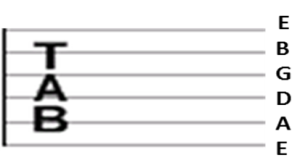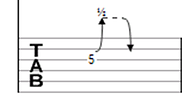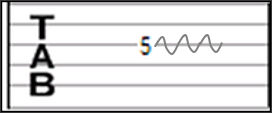Tablature (or tab) writing is widely used in string instruments. And it could not be any different, after all its reading is quite simple and practical, as we will see below. We will show the guitar tab here, because this is the writing used here in the website. The tabs for other string instruments follow the same principle.
The form of writing by tab consists of 6 lines representing the 6 loose strings of the guitar. The order of the strings in the tab, from top to bottom, is as follows:

The thickest and lowest string (low E) is at the bottom, while the thinnest and highest string (high E) is at the top. The other strings follow the same logic that the instrument presents.
On top of each string, a number is placed that represents the guitar fret that must be pressed. Please see below:

In this example, you should press the third fret of the A string with your left hand and play that string with your right hand. When other numbers appear in sequence, you must play one note after another. Observe:

In that case, you should play the 5th fret of the D string, then the 7th fret of the D string, then the 5th fret of the G string, and so on. Note: the number zero represents the loose string (without pressing any frets), for example:
Here, the B string should be played loose. When the numbers appear on top of each other, it means that they must be played at the same time. See the example below:

In this case, you should press all of these frets on their respective strings and play them at the same time. Notice that this is how we represent chords. If a line appears empty at that moment, it should not be played.
Very well, this is tab writing. See how simple it is? In the tab, in addition to showing what you should play, we can also show the techniques used to play each note.
Below are the most common techniques and symbologies.
Hammer-on
This technique consists of hammering the string in a respective fret with the left hand, without the aid of the right hand (the one who plays the note is the left hand only). It can be represented by the letter h next to the number that shows the fret to be played, or by a line connecting one note to another:

Pull-off
Consists of sliding the finger of the left hand down on a string that was being pressed, in order to play that string without the aid of the right hand. Look at the example below (the notation is identical to the hammer-on):

In this case, the finger that was pressing on the 5th fret of the A string should slide downwards (vertical) so that the 3rd fret is played. Notice that this finger on the left hand is taking on the function that it would be playing on the right hand to play the 5th string when the 3rd fret was being pressed.
A Pull-off can also be represented by the letter p. This technique represents the opposite of the Hammer-on.
These two techniques are often used together and are called “legato”. For example:

Bend
Consists of raising or lowering a string with the fingers of your left hand, with the aim of reaching the sound of the frets in front of the fret that was pressed. When the Bend reaches the sound of one fret ahead, it is called a half Bend. When it reaches the sound of two frets ahead, it’s called a whole step Bend, or Full Bend. Higher notes can also be reached. The higher the string is raised, the higher the sound becomes, that is, more steps ahead are possible to be reached. Its notation is an arrow that tells you how many steps to reach:

In this example, the Bend should be half-step. When you want to lift the string and then return to the starting position (reverse bend), the notation is as follows:

Slide
Consists of sliding the finger of the left hand horizontally, going from one fret to another, sliding the finger through the frets of the instrument until reaching the destination. Its notation is a dash:

In this example, you should press/play the 5th fret on the 3rd string and then slide your finger to the 9th fret of that string (letting that string sound in this whole process).
Vibrato
Consists of vibrating the finger after pressing and playing a string and a specific fret. This oscillation is achieved by “shaking” your finger, as if you were making many very short bends quickly up and down. Its notation is a slight wave after the note to be pressed:
Tapping
Consists of hammering a string in a certain fret using the right hand instead of the left. It is the same technique that we saw for the legatos (Hammer-on and Pull-off), only performed by the right hand instead of the left hand. Guitarist Eddie Van Hallen spread this technique in the 1980s. However, there are records of this technique being used long before that, even before Van Hallen was born, so he cannot be considered the “inventor” of Tapping. The fact is that, after him, this technique ended up being widely disseminated and incorporated into the solos of thousands of guitar and bass players.
Tapping is represented by the letter “T”, indicating which fret and string should be pressed with this technique:

Generally, tapping is used in conjunction with Hammer-ons and Pull-offs on the left hand, allowing a “walk” through the fretboard of the instrument using the legato techniques with both hands, as if playing a piano. Therefore, this technique is also known as Two-Hands.
Other techniques
There are dozens of less common techniques that are not standardized. The author of the tab must, in this case, indicate the meaning of the notation somewhere on the tab to avoid confusion.
We recommend that every musician also learn sheet music, as the tablature does not inform the beats and rhythms associated with the song. Although there is also the notation of times in the tab, but it is less popular.
So, don’t limit yourself to the tab and also read our article that clearly teaches you sheet music, unless you are a beginner in music studies. In that case, we recommend that you spend more time practicing the tab and studying music through it, until you feel comfortable with the notes on the fretboard of your instrument. That way, when you learn sheet music, the process will be much more productive and faster.
If you would like to improve your guitar skills quickly, try Guitar Tricks for free. It is the best platform we know.
Recommended articles:
- Guitar notes
- The 5 best online guitar courses
- What is timbre
- Introduction to Blues
- How to name chords
- Music Theory PDF eBook
Back to: Simplifying Theory


